Birth Statistics
The number of registered live births in Region I (Ilocos Region) during the first semester of 2017 summed up to 45,989, a decrease of 3.9 percent compared to 47,857 births on the same period of 2016. The daily average birth occurrence during the first semester of 2017 was computed at 254 births or an average of 11 babies born per hour. The month of January was observed to have the highest average daily births at 285 and 276 babies during the first semester of 2016 and 2017, respectively.
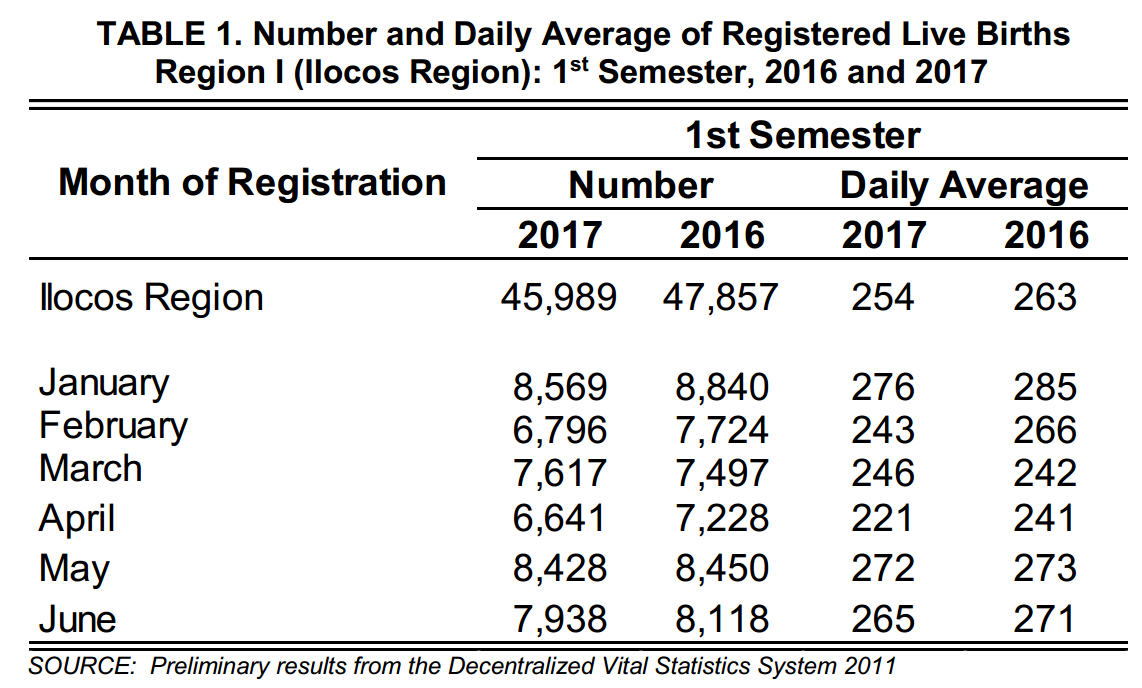
The highest number of registered live births during the first semester of 2016 and 2017 was recorded in the month of January. The percent share of the total births in January to the semestral totals were 18.5 percent in 2016 and 18.6 percent in 2017.
The month of April was observed to have the least number of registered live births at 7,228 and 6,641 during the first semester of 2016 and 2017, respectively.
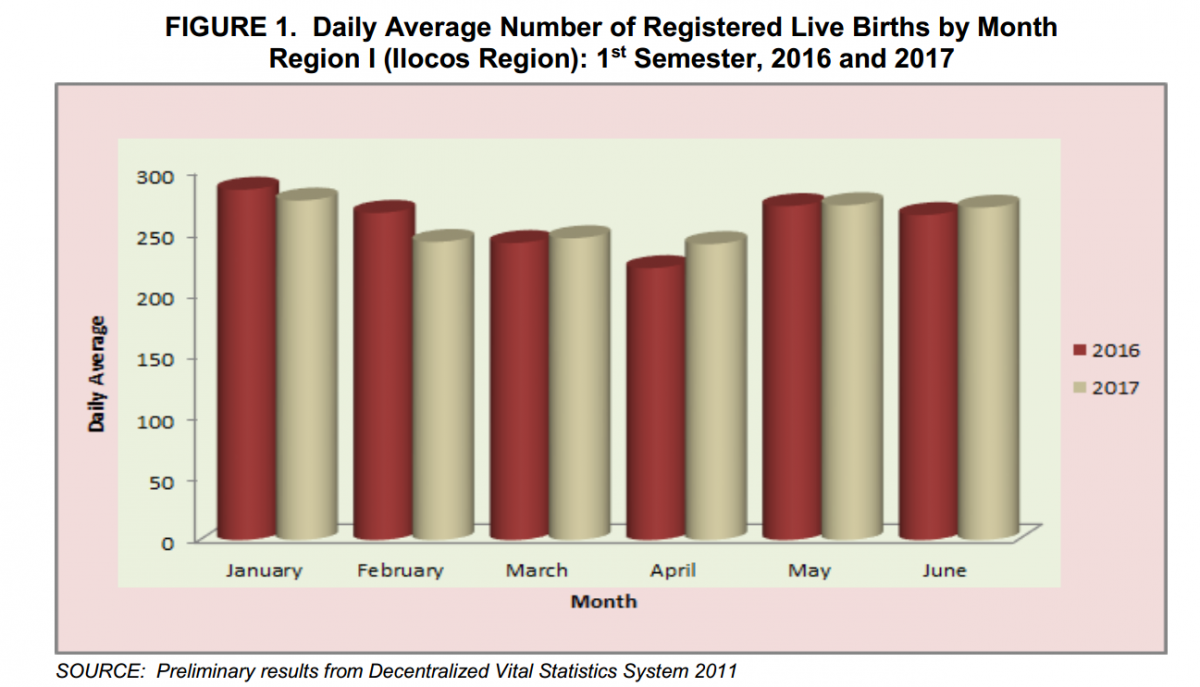
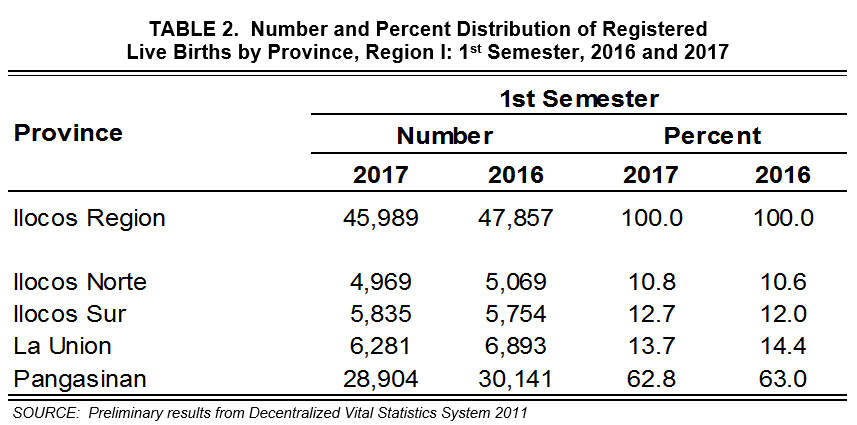
Among the provinces in the region, the province of Pangasinan registered the highest number of births in the first semester of 2017. Its share was more than half (62.8 percent share) of the total registered births in Region I. The province of La Union ranked second with 6,281 births (13.7 percent share), followed by the province of Ilocos Sur with 5,835 births (12.7 percent share) and the province of Ilocos Norte with 4,969 (10.8 percent share).
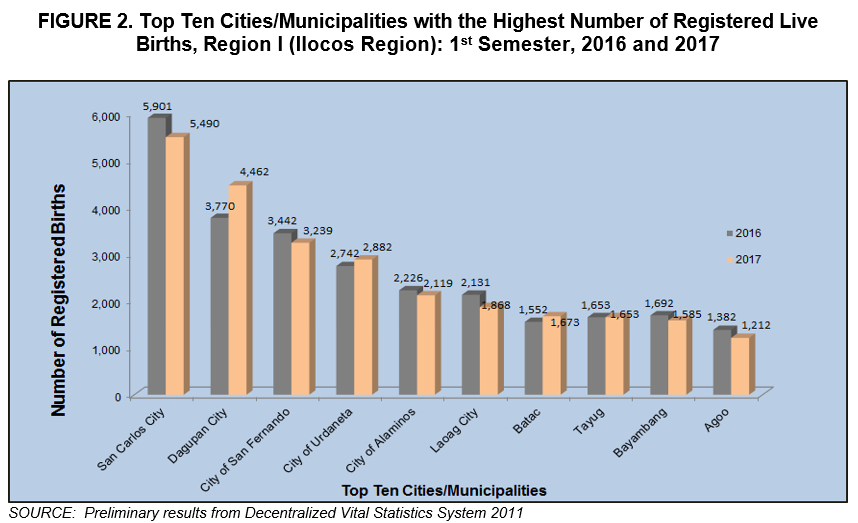
In first semester of 2017, San Carlos City, Pangasinan ranked first among the top ten Cities/Municipalities that registered the highest number of live births with 5,490. This was followed by Dagupan City, Pangasinan with 4,462 births; City of San Fernando, La Union with 3,239 births; City of Urdaneta, Pangasinan with 2,882 births; and City of Alaminos, Pangasinan with 2,119 births. It was also observed that San Carlos City has 521 registered births higher than the total registered births in the province of Ilocos Norte in the first semester of 2017.
On the other hand, Carasi, Ilocos Norte had the lowest number of registered live birth in first semester of 2017 with four (4) registered births. It was followed by Lidlida, Ilocos Sur with seven (7), San Esteban, Ilocos Sur with eight (8), Sigay, Ilocos Sur, and Dumalneg, Ilocos Norte with nine (9) registered live births each.
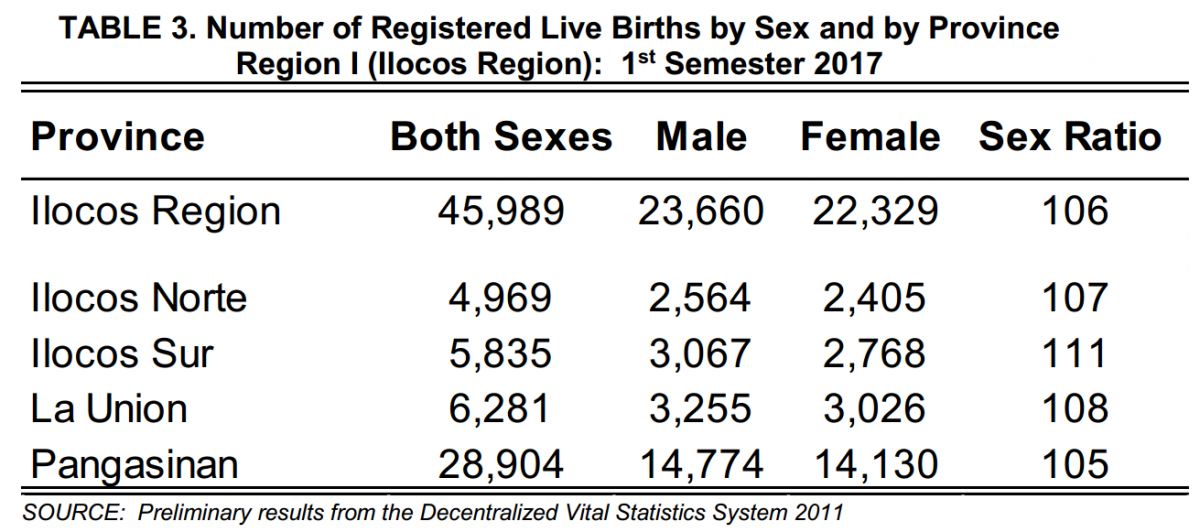
Males (23,660) outnumbered females (22,329) in terms of registered live births during the first semester of 2017, resulting to a sex ratio of 106 males per 100 females.
Three (3) provinces posted a sex ratio that is higher than the regional ratio. The highest sex ratio of 111 males per 100 females was recorded in Ilocos Sur. This was followed by La Union with 108 and Ilocos Norte with 107. On the other hand, the lowest sex ratio of 105 males per 100 females was recorded in the province of Pangasinan.
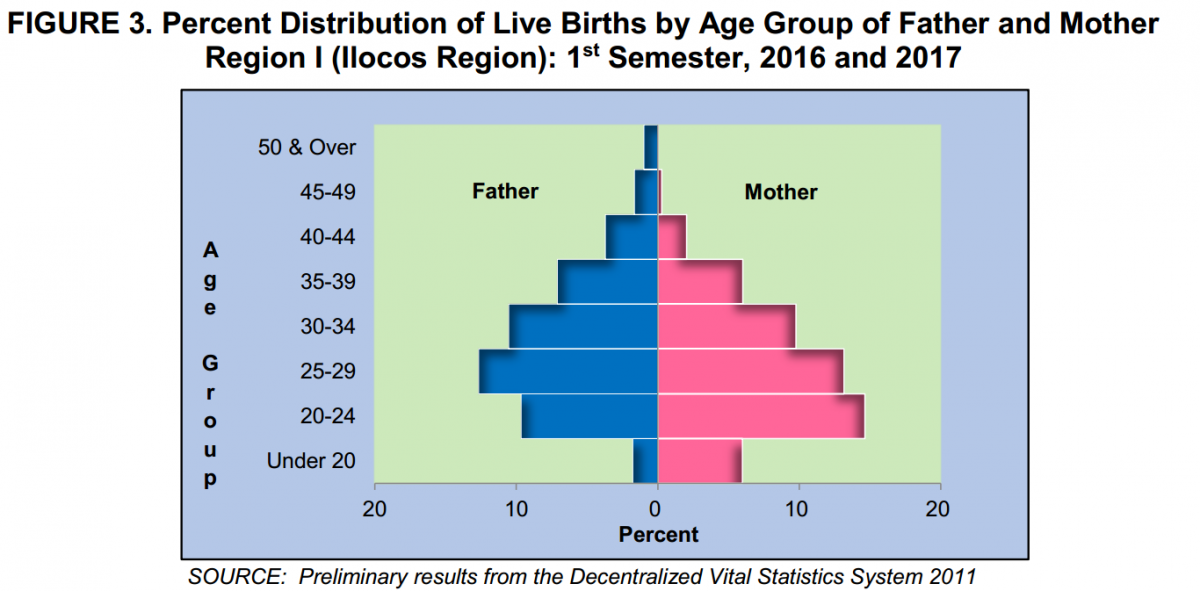
More than a quarter (26.6 percent) or 12,221 of mothers who gave birth in the first semester of 2017 belonged to age group 20 to 24. Meanwhile, the highest proportion of fathers belonged to age group 25 to 29, which is about a quarter (24.7 percent) of the total number of fathers of babies with registered births in first semester 2017. Furthermore, it can also be noted that teenage mothers (4,993) was three times more than teenage fathers (1,475).
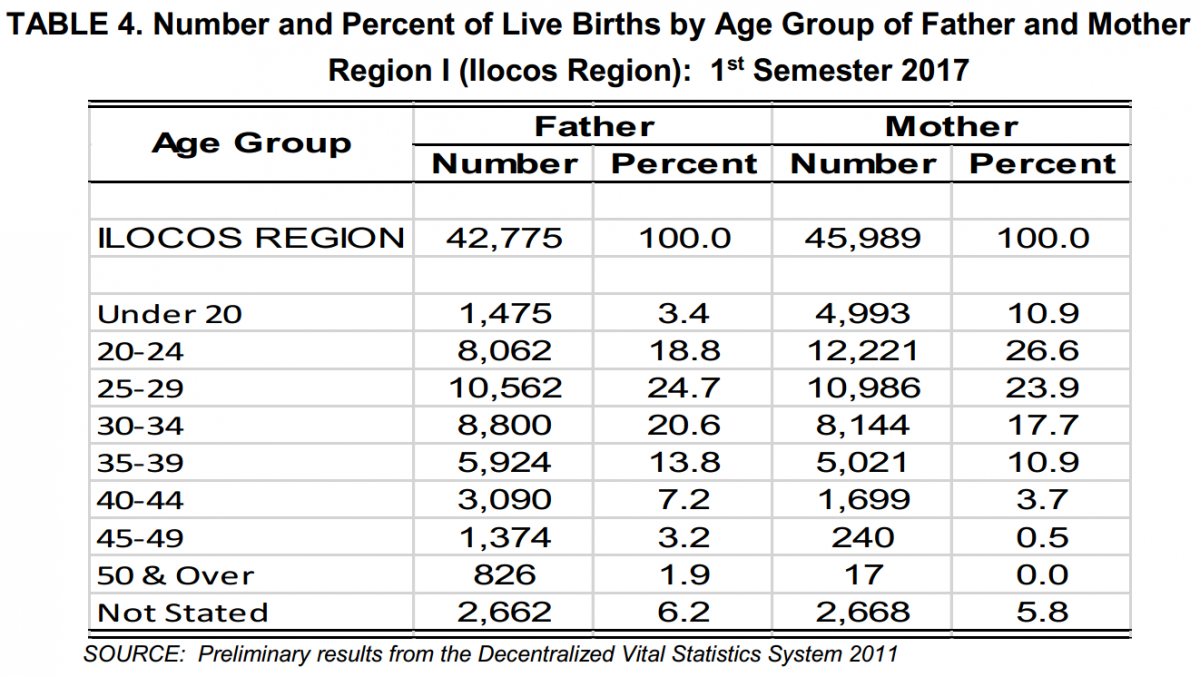
On the other hand, a total of 17 mothers at ages 50 and over gave birth to babies who were registered in first semester of 2017. The number of fathers belonging to age group 50 and over, however, was 48 times more (826) than the mothers. The median age for mothers was 27.6 years old and for fathers, 30.7 years old.
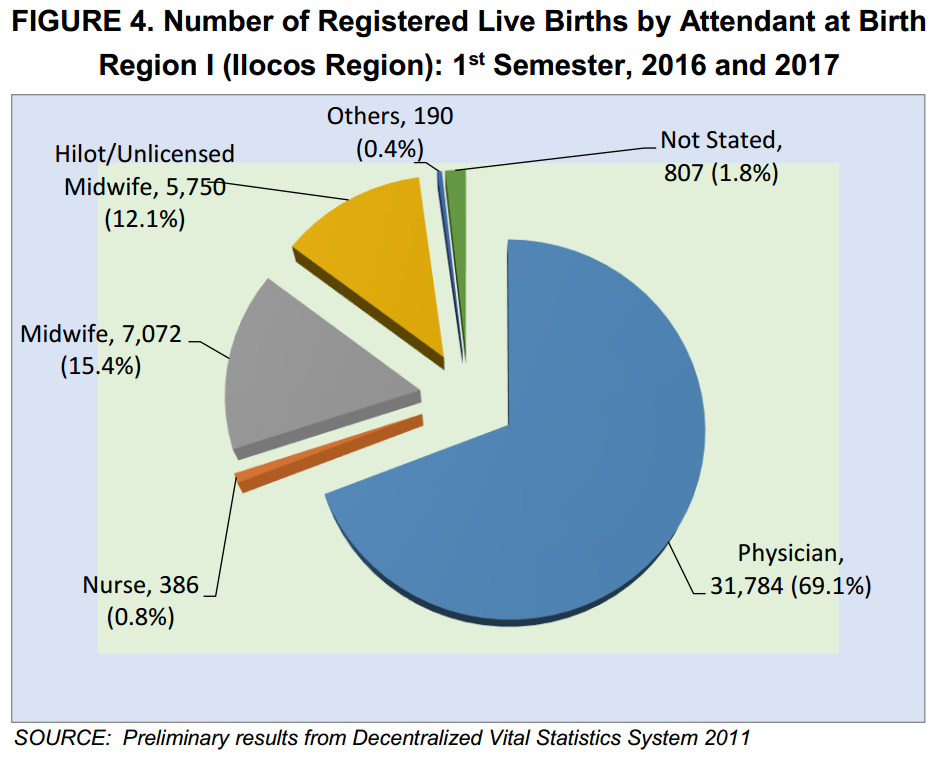
In the first semester of 2017, there were about more than 85 percent or 39,242 of total registered live births were attended by medical practitioners which may either be a physician, a nurse or a midwife. The province of Pangasinan had the highest number of birth deliveries attended by health professionals with 24,963 or 63.6 percent followed by La Union with 5,652 or 14.4 percent, Ilocos Sur with 4,654 or 11.9 percent and Ilocos Norte with 3,973 or 10.1 percent.
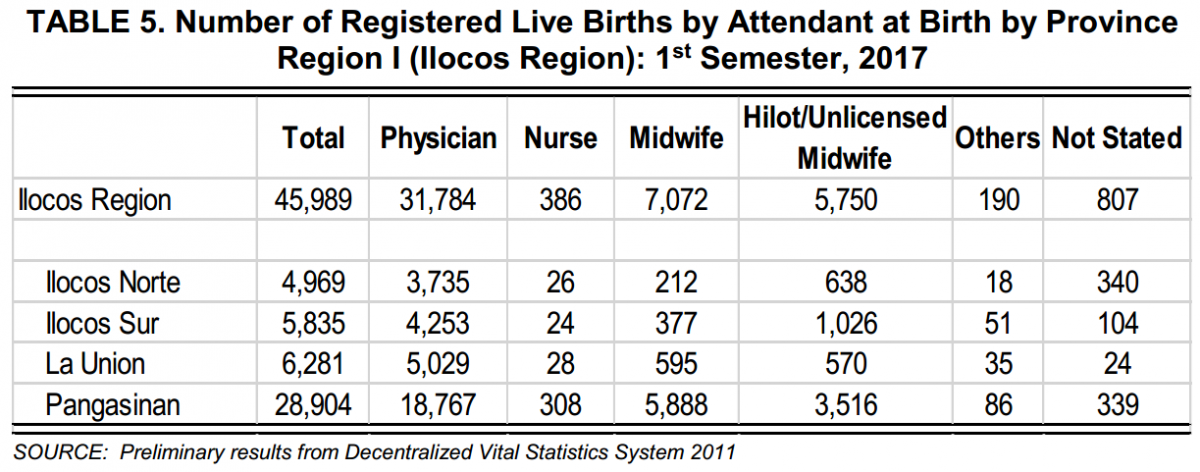
On the other hand, there were 14.7 percent or 6,747 of registered live births were attended by traditional and other birth attendant in first semester of 2017. On top of the list was Pangasinan with 3,941 registered live births or 58.4 percent of its birth deliveries in the region were attended by traditional and other birth attendants. Ilocos Sur ranked second with 1,181 (17.5 percent share) followed by Ilocos Norte with 996 (14.8 percent share) and La Union with 629 (9.3 percent).
Marriage Statistics
There were 17,932 marriages registered during the first semester of 2017, showing a decrease of 4.9 percent from the figure on the same period last year of 18,861 marriages.
Two (2) provinces recorded an increase in the number of registered marriages from first semester of 2016 to first semester of 2017. A bigger increase was noted in Ilocos Sur from 2,495 to 2,609 marriages (4.6 percent). While that of Ilocos Norte increased from 1,948 to 1,992 marriages (2.3 percent).
On the other hand, the provinces that posted a decrease in the number of registered marriages were Pangasinan from 11,622 to 10,658 (8.3 percent) and La Union from 2,796 to 2,673 (4.4 percent).
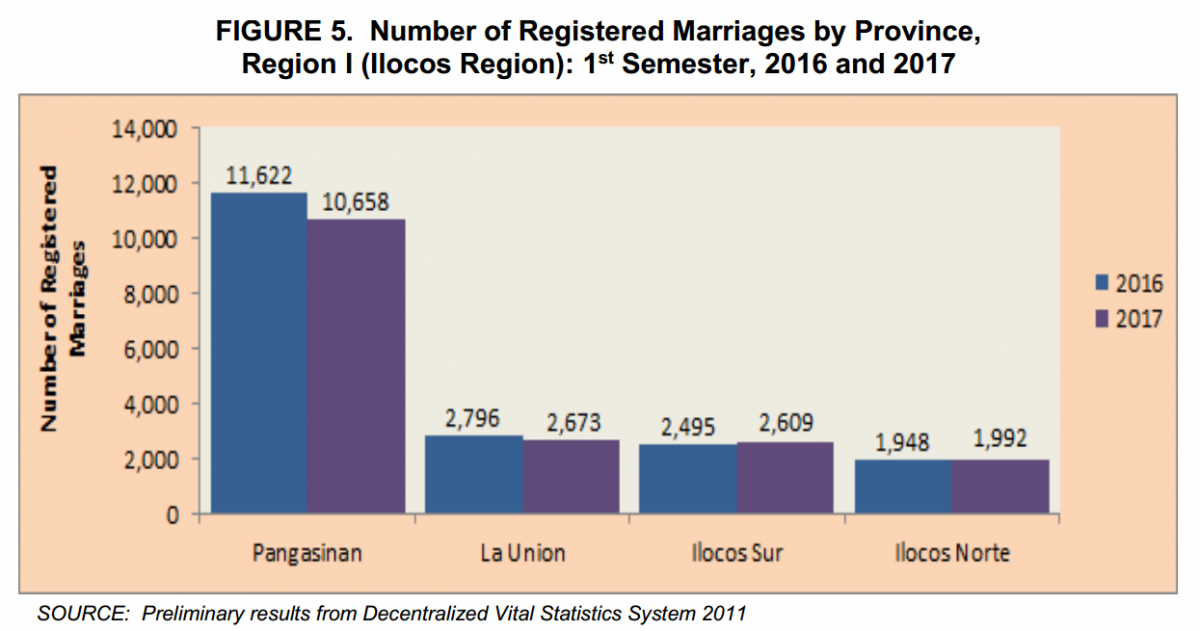
The number of registered marriages in the province of Pangasinan went down to 10,658 during the first semester of 2017 from 11,622 in the same semester of 2016, but it remained with the most number of registered marriages in the region. La Union ranked second with 2,673 (14.9 percent share) followed by Ilocos Sur with 2,609 (14.5 percent share). In 2016, La Union ranked second with 2,796 marriages (14.8 percent share) while Ilocos Sur ranked third with 2,495 marriages (13.2 percent share).
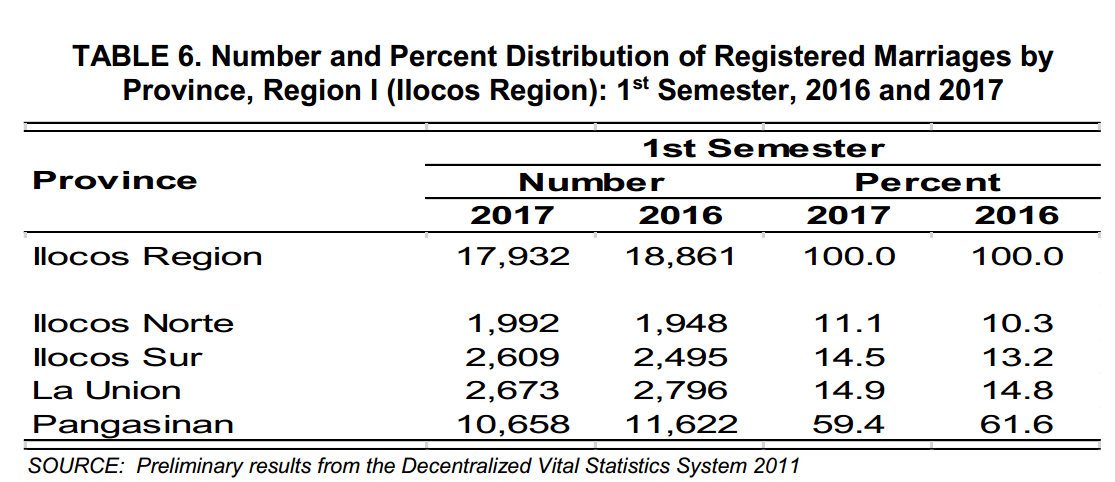
On the other end, the province of Ilocos Norte posted the least number of registered marriages during the first semester of 2016 and 2017 with 1,948 (10.3 percent share) and 1,992 (11.1 percent share), respectively.
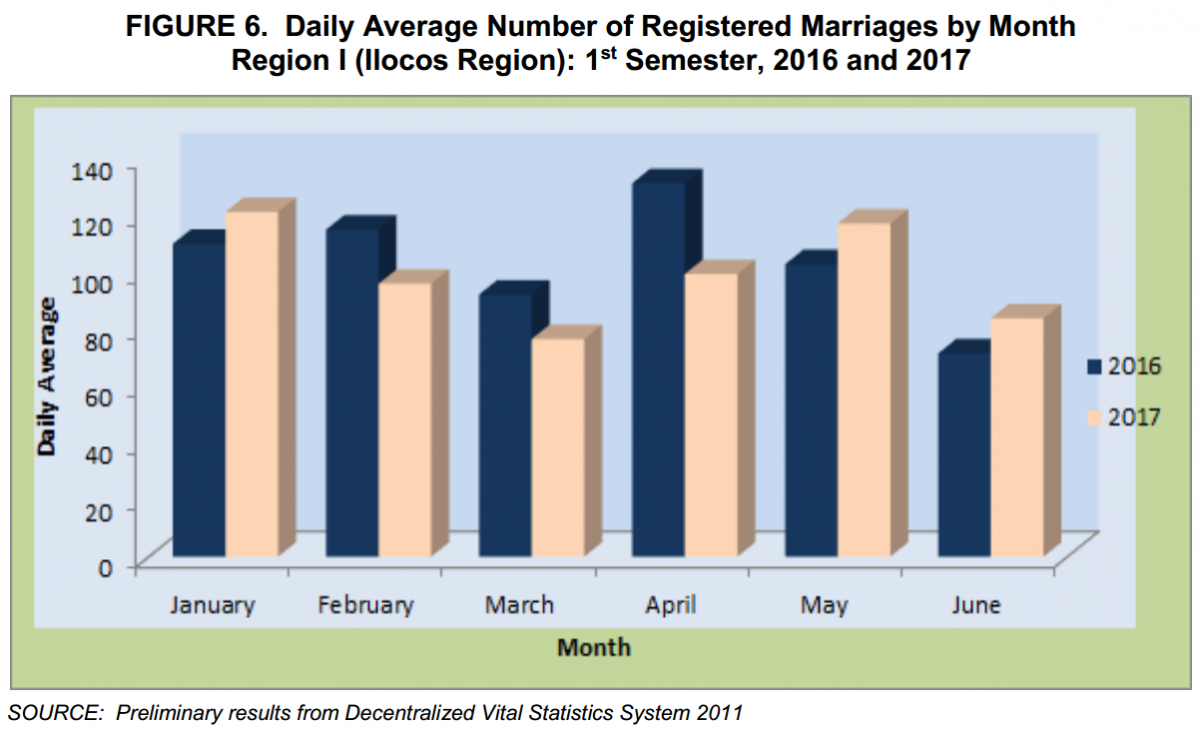
The month of January was the most preferred month to tie the knot during the first semester of 2017 with a total of 3,756 marriages. It corresponds to a daily average of 121 registered marriages which surpassed the regional daily average number during the first semester. In the same period of last year, April was the most preferred month to tie the knot with a total of 3,937 marriages translating to a daily average of 131 registered marriages. The least number of marriage occurrences during the first semester of 2017 was recorded in March posting a daily average of 76. On the other hand, June has the least number of marriage occurrences in the same period of 2016 with a daily average of 71.
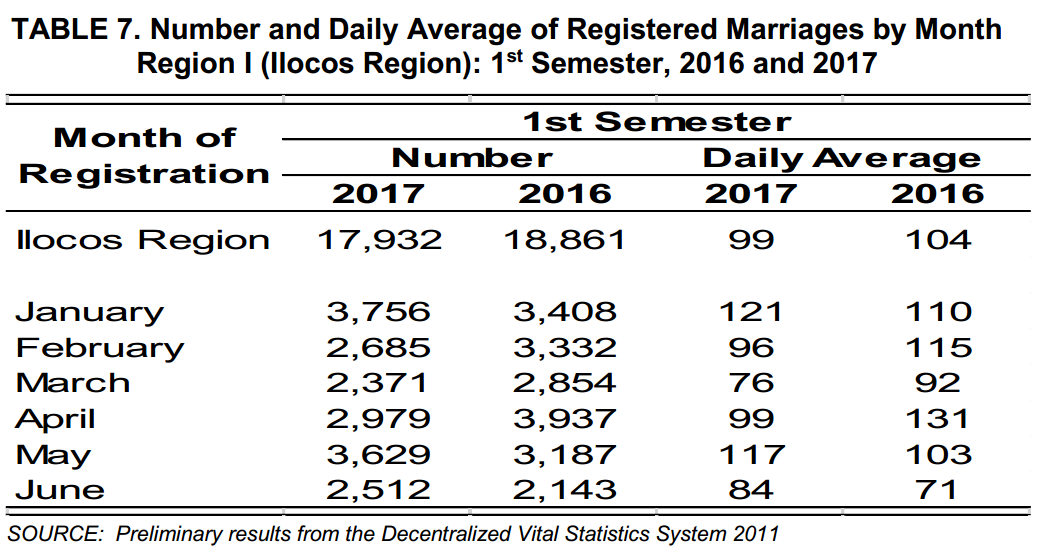
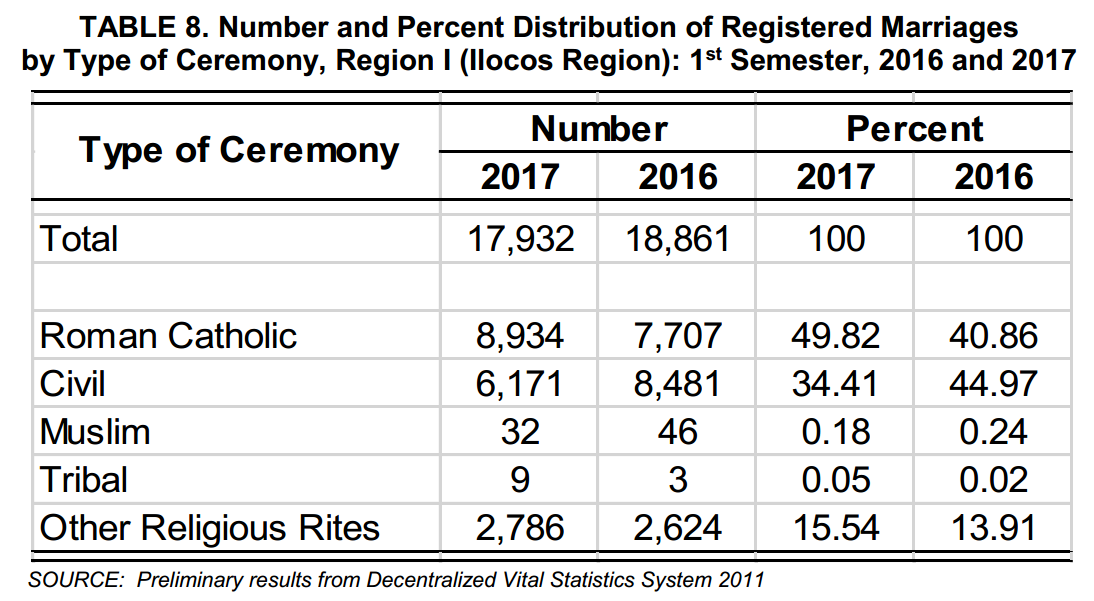
Marriages officiated in Roman Catholic Church topped the list among all types of marriage ceremonies in first semester of 2017. It comprised 8,934 marriages or 49.82 percent of the total reported marriages. Marriages performed in civil rite ranked second with 6,171 marriages or 34.41 percent share followed by other religious rites with 2,786 or 15.54 percent.
In the same period of last year, marriages contracted through civil rite registered the highest number of marriages with 8,481 marriages or 44.97 percent share, followed by Roman Catholic with 7,707 marriages or 40.86 percent share.
Death Statistics
A total of 16,961 deaths were registered during the first semester of 2017. The figure indicated a decrease of 3.3 percent death occurrences from the 2016 figure of 17,531.
The province of Pangasinan ranked first in terms of the number of registered deaths during the first semester 2017, with a total of 9,681 or 57.1 percent share of the total registered deaths in the region. La Union placed second with 2,707 registered deaths (16.0 percent share), followed by Ilocos Sur with 2,360 (13.9 percent share) and Ilocos Norte with 2,213 (13.0 percent share).
In the same semester of 2016, Pangasinan recorded 10,044 deaths or 57.3 percent of the total registered deaths in the region. La Union registered 2,805 (16.0 percent share), Ilocos Sur with 2,479 (14.1 percent share) and Ilocos Norte with 2,203 (12.6 percent share).
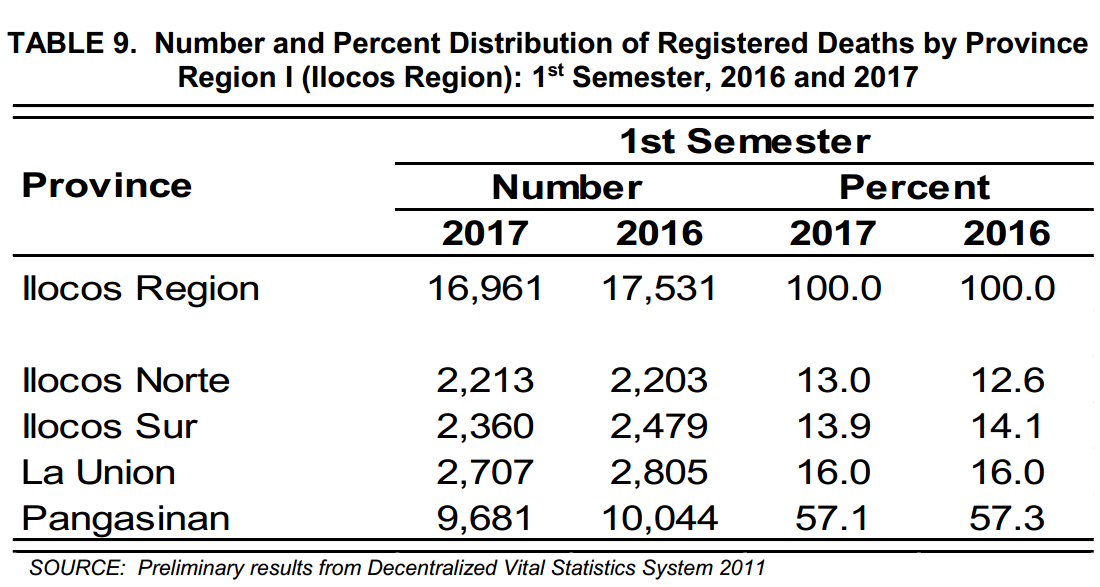
Comparing the two periods, only Ilocos Norte posted an increase at 0.5 percent from 2,203 deaths in 2016 to 2,213 deaths in 2017. On the other hand, Ilocos Sur reported the highest percent decrease at 4.8 percent. Followed by Pangasinan with 3.6 percent and La Union with 3.5 percent decrease.
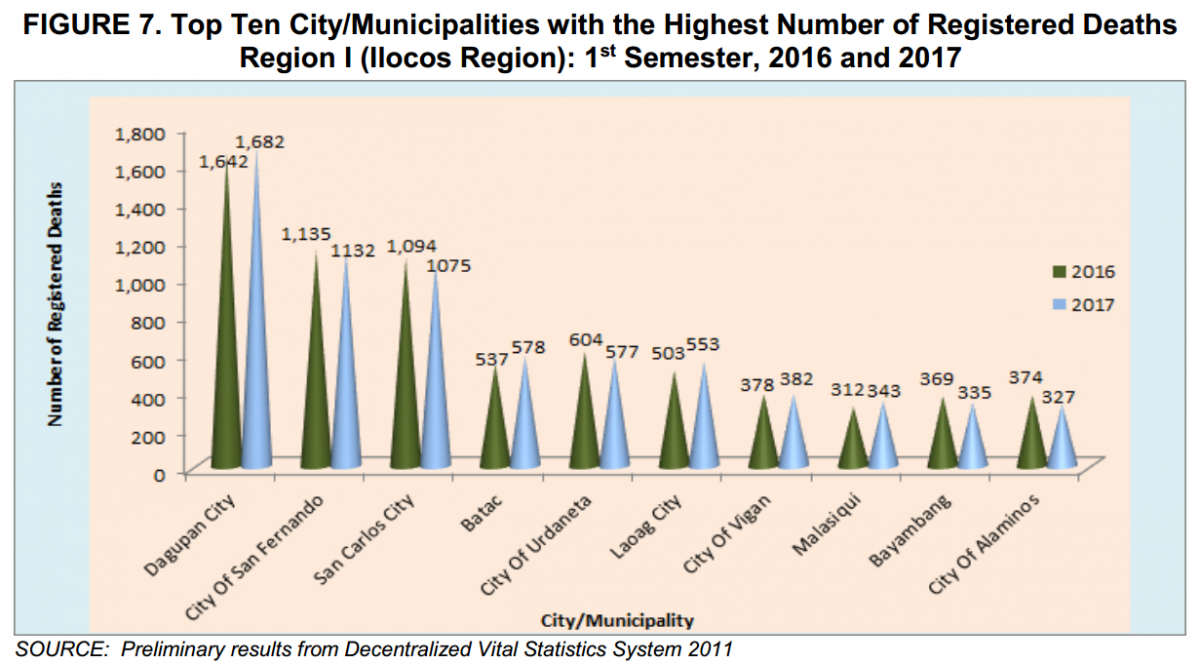
The cities of Dagupan, San Fernando, San Carlos, Batac and Urdaneta posted the highest number of registered deaths in the first semester of 2017 with 1,682, 1,132, 1,075, 578 and 577 deaths, respectively. On the other hand, the municipalities of Adams, Dumalneg, Carasi, Sigay, Lidlidda and Nueva Era had the least number in terms of the number of registered deaths: Adams and Dumalneg with two (2) registered deaths each; Carasi with five (5); Sigay with six (6); and Lidlida and Nueva Era with nine (9) each.
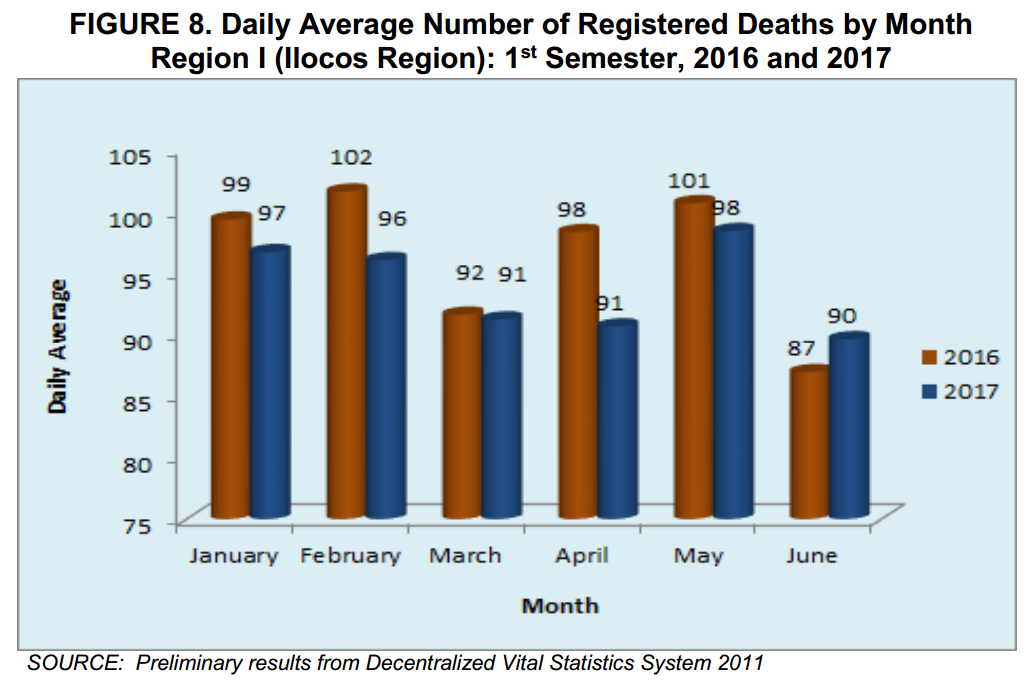
During the first semester of 2017, mortality was at its peak in the month of May with total registered deaths of 3,048. It was followed by January with 2,995, March with 2,826 and April with 2,718 death occurrences. The number of deaths in the month of May 2017 translates to an average of 98 death occurrences per day. The figure was higher than the daily average death occurrences in the region.
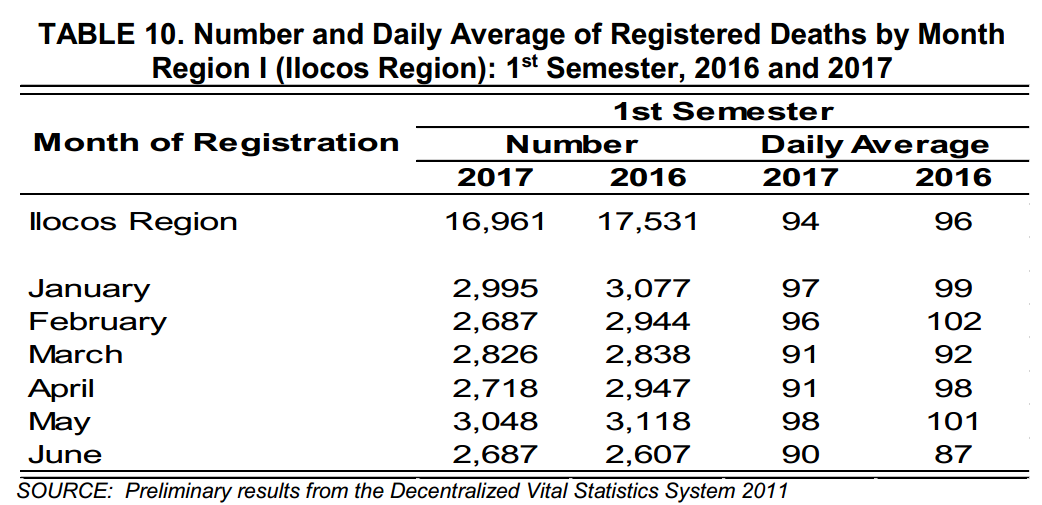
Similarly, the highest number of registered deaths during the first semester of 2016 was in the month of May with 3,118 death occurrences, followed by the month of January with 3,077. The smallest number of registered deaths was in June with 2,607. February 2016 has the highest daily average of 102 death occurrences followed by May with a daily average of 101 death occurrences.
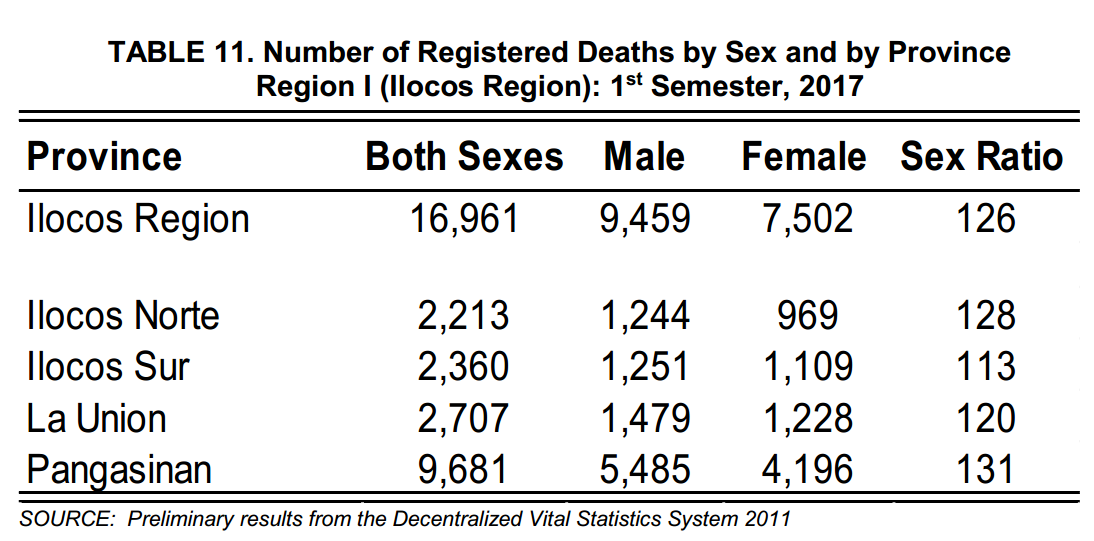
There were more death occurrences among males (9,459) than females (7,502) in Region I during the first semester of 2017. The computed sex ratio during the semester was 126 male deaths for every 100 female deaths.
Pangasinan posted the highest sex ratio in the regional with 131. Ilocos Norte ranked second with 128 and followed by La Union with 120. The lowest computed sex ratio of 113 male deaths per 100 female deaths was noted in Ilocos Sur.
Explanatory Notes
Data on births, deaths and marriages presented in this release were obtained from the Certificate of Live Birth (Municipal Form 102), Certificate of Death (Municipal Form 90) and Certificate of Marriage (Municipal Form No. 97) that were registered at the Office of the City/Municipal Civil Registrars and forwarded to the Philippine Statistics Authority - Provincial Statistical Offices in Region I. Information included births, deaths and marriages registered in January to June 2017 and January to June 2016.
SGD. SOCRATES L. RAMORES
Regional Director

